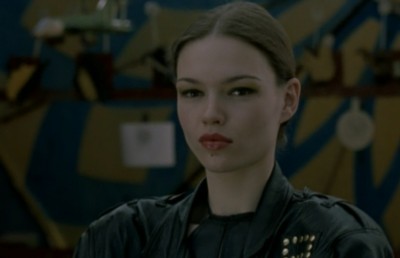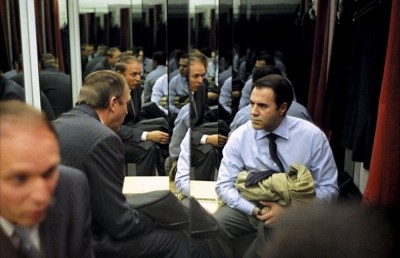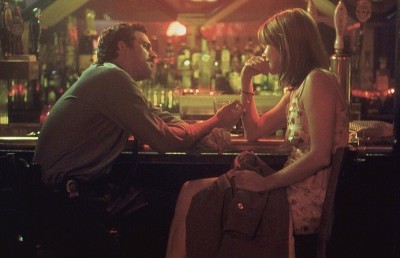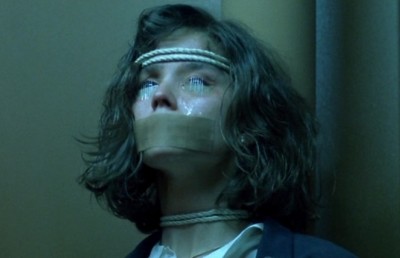Evilenko
Serial Killing and the Fall of Communism
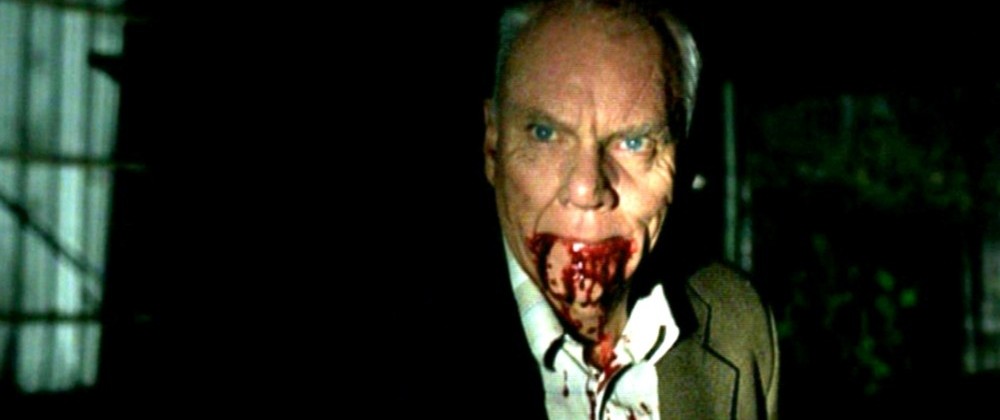
Evilenko is a fictional film based on the real life Soviet serial killer Andrei Cikatilo (sometimes spelled Chikatilo), a human monster who terrorized (mostly) the port city of Rostov from 1978 until his incarceration in 1990. [1] Cikatilo has the dubious distinction of being the most prolific (if that is the right word) serial killer in modern history, with anywhere from 52 to 55 victims, according to different accounts. More disturbing is the method of his killing, which included rapacious, wolf-like attacks of live dismemberment, multiple stabbings, and cannibalism. Reading descriptions of his killings makes one sick to the stomach, and is a disturbing reminder of the depraved depths to which a sick mind can sink. The film stars Malcolm McDowell as the killer (here renamed Andrei Evilenko, not the most subtle of names), Marton Csokas as Vadim Timurovic Lesiev, the head magistrate placed in charge of tracking down the killer, and Ronald Pickup as Dr. Aron Richter, the psychoanalyst enlisted to help track down Evilenko. The director is David Grieco, a former journalist turned filmmaker who wrote a fictionalized account of his journalistic reports on Cikatilo entitled The Communist Who Ate Children, before turning to this, his first feature film.
Evilenko is, along with Henry: Portrait of a Serial Killer, one of the more grim cinematic depictions of a murderous mind. Everything from the brooding score by David Lynch regular Angelo Bandalamenti, the somber, grey-brown lighting palette, the rigid, ‘lifeless’ camera movements (cinematographer Fabio Zamarion), to the depressed looking locations renders an unrelenting sense of destitution and oppression. Although the film does not shirk from the gravity of the crimes, the heinous murders are never overtly graphic or gratuitous. In fact the film goes one step further by underscoring how traumatic the sight of a murder can be to even a trained person. In most serial killer films the gruesome sight of a murder may cause the witness to place their hand over their mouth, kneel over, throw-up, or even faint. In Evilenko a 21 year-old soldier accidentally comes across Evilenko in the midst of a savage killing, his bloodied face hovering over a mangled human corpse like a lion on a kill. The sight causes the young man to collapse in a state of shock, unable to even speak when questioned by the authorities about what he saw.
The film begins with a mid-credit scene, with the camera in an overhead position looking down at a man and little girl seated opposite each other on a tree branch in a wooded area. As the man recites a story the camera cranes in a sinewy motion down to the ground and to a close-up of the man, who has now finished telling the story. The girl (off screen) asks, “Is that the end?” The teary-eyed man replies, “….Yes.” The image fades to black, the momentary silence broken by the piercing scream of the little girl, the human intonation giving way to a bird-like screech. A red (EVIL) and white (ENKO) title card appears. The first post-credit shot begins with the camera peering from behind thick bushes at a schoolyard filled with children, then begins to crane screen right following a group of running children (the titles “Kiev March 14, 1984” appear) and ending up at an overhead angle of the same man, Evilenko, seated on a bench reading a newspaper. The position of the camera subtly recalls the previous scene and foreshadows Evilenko’s modus operandi: luring his young victims into a wooded area (areas that are later referred to by number, such as wood strip #2), where he would then proceed to mutilate them in isolation. The shot then cuts to a higher angle of the same setting, only now the silhouette of a large statue fills the lower right quadrant of the frame, giving the impression of looking over the proceedings. Thousands of such large statues commemorating communist figureheads (mainly Stalin and Lenin) were erected throughout Soviet cities during Stalin’s reign and have come to symbolize Eastern Block communism. By linking Evilenko to this iconic representation of communism Grieco introduces the film’s driving symbolic force: Evilenko as a metaphor for the fall of communism.
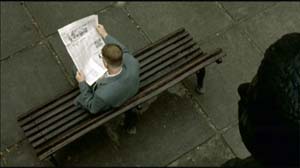
Like the real life Cikatilo, Evilenko clearly had ‘issues’ with sex. It seems that while impotent in normal sexual encounters, he could be sufficiently aroused during the throes of murder, something he came to realize inadvertently during his first murder. The sexual nature of his violent crimes seems confirmed by the police records, which state that during Cikatilo’s first murder of a nine year old girl the usually impotent Cikatilo became sexually aroused long enough to achieve orgasm, which may have then triggered the long series of sexually motivated murders. Grieco establishes the sexual-sadistic nature of his character in the second scene of the film, which takes place in the elementary school where Evilenko teaches. During a lecture on communism (what else) he spots a young girl in the back of the class lifting her skirt for the gaze of a male classmate. Evilenko detains her after class, drops his trousers and exposes himself to the little girl. Talking in euphemisms (flying, singing) he attempts to arouse himself, but when he can not get an erection the girl begins to laugh and says, “He [referring to the penis] can’t talk because he is dead.” Evilenko thrusts her onto his desk but she stabs him with a letter opener and runs out of the class. While everything occurs below or off-frame, the dialogue and situation is harrowing, and succinctly establishes: 1) Evilenko’s sexual inadequacy 2) the sexual nature of Evilenko’s crimes, and 3) a possible reason for why most of his victims were young children. The scene is also made relevant by being echoed in the later interrogation scene where the magistrate Vadim Lesiev ‘cracks’ Evilenko and gets him to admit to the crimes.
In the above noted scene where the little girl exposes herself to a classmate, the shot itself is brief, lasting only a few seconds, but behind the little girl, looking directly over her, is a bronze statue of Stalin. This is a wonderfully perverse gesture, a signifier of one of the central tenets of Socialist Realism: the desexualisation of life. [2] This type of understated, yet expressive style is a major characteristic of the film, and I can only surmise that many of the critics who have been unkind to the film did not pick up on these meanings.
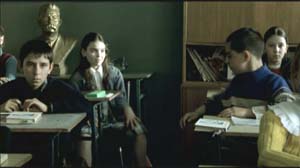
“Impotence is not my problem, it is my privilege.”
The above heading is a wonderful line spoken by Evilenko in response to Lesiev’s enquiry into his sex life during the interrogation scene. As noted above, sex was nowhere to be seen within the cultural sphere of the Soviet Union and censored by the official party art dogma of Socialist Realism. This repression of sexuality becomes a lifestyle for Evilenko (and the real life Cikatilo). When questioned by Lesiev about their sex life, Evilenko’s wife gladly informs him that they have not had sexual relations in years. Likewise for Cikatilo, who is said to have been celibate from 1984 onwards. Evilenko’s wife, as staunch a communist hardliner as her husband, reminds Lesiev, “If you are a communist, children belong to everyone.”
Some of the more striking scenes in the film, which bring to the fore the sexual-sadistic nature of the killings, occur during the long interrogation sequence near the end of the film. In this sequence Lesiev dons a white doctor’s lab jacket and assumes different identities in order to try to tap into Evilenko’s barely suppressed psycho-sexual dark side. The scene is lit and staged like a living Francis Bacon painting, with the two men seated, at first dressed and then nude, in front of a black background and red-brown floor, the camera continually encircling them. The pivotal moment comes when Vadim Lesiev feigns being a little boy, which causes Evilenko to lose awareness and stray over to his psychotic half and become the ‘vampiric’ stalker. Evilenko tells the ‘boy’ to take his clothes off and then takes his hand –as he attempted with the little girl in the opening scene– and places it to his genitals. Encouraged by Lesiev, Evilenko achieves an erection, after having claimed his impotence. The interrogation and arrest of Evilenko concludes with a moment of chilling beauty. Rather than speak his confession into a tape recorder, Evilenko asks Lesiev to take pen to paper and write down his confession. The camera slowly dollies into Evilenko. As he begins to recite the 55 murders with the detailed precision of a book keeper (name and age of victim, date, place), a horizontally moving scroll of photographs of all the victims is superimposed over his face. After completing his ‘death roll call,’ the image cuts to a close-up of Lesiev, seated in stunned silence, a tear running down his cheek, and then back to a medium close-up of Evilenko, who stares at Lesiev and says, with nary a hint of remorse, “We’ve done a good job, haven’t we comrades.”
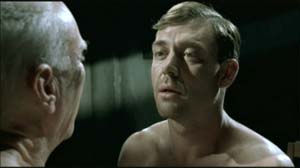
Director Grieco takes full advantage of the historical coincidence linking the capture of Andrei Cikatilo (in 1990) with the fall of Communism in the Soviet Union (1991) by suggesting a metaphorical parallel between Evilenko and communism: as communism collapses, so too does Evilenko. Although there are hints of this in the dialogue, more than a cursory knowledge of Soviet and Russian history adds to this implicit meaning. In the film Evilenko is a hard line, old school communist, full of hatred for anyone connected with Gorbachev and the reformers. The revelation of Andrei Cikatilo’s crimes sent shockwaves around the world. According to Soviet ideology, serial killers were a by-product of decadent western style capitalism and therefore could never appear under communism. Rather than exposing this fallacy, Cikatilo’s killings were kept under wraps by the authorities, which of course had the added effect of placing its population in further peril. This ‘cover’ up of the serial killer for ideological reasons (and there were other serial killers, Cikatilo was not the only one) has its parallel in life under Stalinism. In 1956 at the Twentieth Party Congress, three years of Stalin’s death, the new communist leader Nikita Khrushchev made his famous denouncement of Stalin’s ‘cult of personality’ and his crimes against the Soviet state. The truth behind the twenty plus years of political murder, suppression of dissidents, and mass starvation had been covered up in much the same way as Andrei Cikatilo’s killing spree. In his denouncement of Stalin, Khrushchev even made mention of the role of cinema in the fabrication of historical lies and the distorted view of Russia. According to Khrushchev, Stalin had not stepped foot in a village since 1928 and, “it was through movies that he [Stalin] knew the countryside and its agriculture, and these films greatly embellished reality. Numerous films painted the Kolkhosian way of life by showing us tables tottering under the weight of turkeys and geese. Obviously Stalin believed it was really like that.” [3]
This deception which the people of Russia lived under during Stalinism, and which informed the handling of the Andrei Cikatilo case, is reflected in several forms throughout the film. To begin, Evilenko cast a shadow of deception everywhere he walked: the elementary school where he taught, with his wife and two children, with his other co-workers after his dismissal from teaching, and, of course, with his victims. The character of the psychoanalyst, Dr. Aron Richter, also falls to a form of deception, a self-deception instilled by a unwavering belief in his discipline. Although Richter is able to quickly track down and identify the killer, where the police were not able to for years, his attempt to thwart and capture Evilenko is seriously misguided. Richter finds Evilenko in the woods about to murder a girl. He stops Evilenko by assuming the identity of his father and appealing to his loss of a strong male authority figure. For starters the attempt is misguided simply from a practical standpoint: since Richter had access to all police records he would have known that Evilenko’s father died in a Siberian camp for acts against the state, and that because of this Evilenko hated his father. (“My father was an enemy of the people.”) Evilenko listens to Richter’s ‘fatherly’ appeal and then nonchanlantly stabs him to death. Another form of deception is then introduced. Once diverted by Richter, Evilenko’s victim runs off to apparent safety. Evilenko watches as the little girl escapes into the background of the shot, running up an embankment leading to train tracks. The girl reaches the top of the embankment, at which point a train enters and cuts across the frame. From the distant perspective it appears that the girl has been crushed by the oncoming train. The scene then cuts to a closer point along the embankment. The camera cranes left across trees, over the moving train to frame the girl running off to safety in the distance.
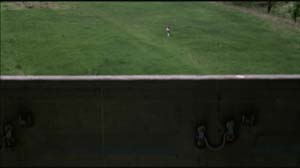
Through this impressive shot, Grieco has cleverly revealed the deception to his audience, but not to Evilenko, who is seen in the next scene crying in his wife’s arms over having helplessly witnessed the death of a little girl. The moment reveals again the different layers of meaning that Grieco plants but leaves for us to decipher. Why is Evilenko crying over the death of a girl whom he would have murdered anyway? Perhaps his ability to see the death from a perspective outside his own is confirmation of his mental illness, his ‘split personality’? Or perhaps he is feigning tears to simply continue deceiving his wife?
Oddly enough, the police magistrate Lesiev is the shrewder psychoanalyst, as he later assumes the persona of a victim to trap Evilenko into a compromising position (recalling the clever detective, played by Harvey Keitel, who psychoanalyzes the psychoanalyst, played by Art Garfunkel, in Nicolas Roeg’s Bad Timing, 1980).
At the core of this film’s effectiveness, buttressing the subtly expressive visual style, are the three great performances from its central players, Malcolm McDowell as the killer Andrei Evilenko, Marton Csokas as his pursuer and confidant (of sorts), magistrate Vadim Timurovic Lesiev, and Ronald Pickup as the gay/pedophile psychoanalyst who agrees to help track down Evilenko, Dr. Aron Richter. Although there are some weak performances in some of the smaller roles, such as Csokas’ wife (often a result of bad dubbing), these three (non-dubbed) performances are outstanding. Perhaps it is too easy to single out McDowell because of the intensity inherent in the extremities of his persona, but playing such a larger than life character can also have challenges, which McDowell is thankfully up to. From the first time we see him in 1984, to the his final appearance in the court room in 1992, McDowell’s whole entity changes, his body movement, makeup (hair goes from brown to white), and vocal intonation transformed from that of a confident predator to a frail, fractured psyche; his ‘bird walk’ (as he calls it in the DVD supplemental interview), where he hunches his upper body forward with his arms at his side and hands cusped backwards behind his back, is a stunning expression of a predatory human in action.

Csokas also excels in the equally difficult role of a ‘comrade’ also faithful to the old communist ways, but slowly coming to terms with the new post-communist Russian. In the extremely brave finale to the interrogation sequence Csokas goes toe-to-toe with McDowell and more than holds his own. When both men undress and sit in front of each other stark naked, the black background setting them off in further relief, it is an apt expression for how they are baring their soul to each other, and to the audience. In this scene Vadim Lesiev speaks in the voice of a young boy to attempt to lure Evilenko into his predatory state. After Evilenko is aroused Lesiev offers his neck to Evilenko, who takes to the bait like a moth to light. This moment completes the vampiric imagery which has been hinted at earlier in the film; for example, in the way Evilenko is given powers of hypnosis over some of his victims (like a Svengali figure, but more fittingly in my reading, like Count Dracula). In this context Lesiev acts like the sacrificial Nina Harker at the end of Murnau’s Nosferatu, who offers her neck to the vampire Orlok long enough for the sun to rise and destroy him.
The third critical role is that of the psychoanalyst Dr. Aron Richter, played by the British actor Ronald Pickup. Richter gets some of the better lines in the film and, as a Jewish, gay psychoanalyst, represents a faction of dissents suppressed and killed during Stalinism. Also, while science was an esteemed field during communism, psychoanalysis, not being the most rigorous and theoretical of sciences, could not have been a favorite discipline among the sciences during the communist Soviet Union. It is to Pickup’s credit that he plays a man once convicted of sexually molesting a boy in a movie theatre, and yet comes across as a sympathetic character. In the scene where Lesiev visits Richter’s home to convince him to help with the case, the walls of his study are, interestingly, lined with paintings of famous men of science, whereas in all other locations we see paintings of political figures (Stalin, Lenin, or Gorbachev).
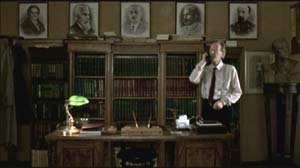
The conversation between two men of different generations (Richter is considerably older) is very revealing with regards post-communist Russia, with Richter painting a very bleak vision for the future of Russia. Richter tells Lesiev that he is not surprised that a human could be capable of these heinous crimes, especially not in Russia where, as he states, all the healthy, intelligent minds –the dissidents– were placed in asylums, while the truly insane people were left free to roam the country (I would guess what he implies here is, free to run the country). “This country is on the verge of a major epidemic. He’s [Evilenko] the virus. You kill him and you’ll never find the antidote.” Perhaps as an affront to the field of psychoanalysis, in the end Evilenko was found legally sane and sentenced to death by execution. Of course a plea of insanity would have saved his life, which the authorities were probably not willing to accept for a range of reasons (more political than moral).
Bolstered by the success of Silence of the Lambs in 1991, the serial killer film has developed into one of the most prolific and popular contemporary film genres (or, sub-genres of the horror film). The success of these films is based largely on the thrills and chills associated with the genre (graphic violence, inhumane acts, ‘charismatic’ serial killer, battle of wits between killer and profiler, etc.). The better of them explore the psychological or moral dimension to serial killing. Evilenko belongs to that rare breed of serial killer film where social and political meaning rests on an equal footing with the above noted thrills and chills associated with the genre. In this case, the central protagonist’s rise and fall parallels the tail end of the Cold War and the fall of communism in the Soviet Union. Having a character on the cusp of historical change is reminiscent of the first important, and arguably still finest, sound era serial killer film, Fritz Lang’s M (1930). Several film historians have noted (most famously, Siegfried Kracauer in From Caligari to Hitler, a psychological study of the German film) of Lang’s archetypical serial killer film, that the urban chaos and uncertainty represented by a killer on the loose was a (largely unconscious) reflection of the social and political turmoil of Weimar period Germany, and the imminent rise to power of the Nazis. I am not suggesting, here, that Evilenko is in the same class as M, but that it is a solid, uncompromising film which should be recognized as an important contribution to the ever growing body (pun intended) of serial killer films.
Endnotes
1 There is another film based on the life of Andrei Cikatilo, Citizen X (Chris Gerolmo, 1995).
2 Other ‘rules’ of Socialist Realism included: the elimination of complex art, the bureaucratic control of the arts, the glorification of “life as it should be,” the cult of the personality, the glorification of war, and the switch from the collective hero to single hero.
3 Nikita Khrushchev, quoted in Andre Bazin, “The Stalin Myth in Soviet Cinema,” ed. Bill Nichols vol. 2. Berkeley, Los Angeles: University of California Press, 1985, p. 40.



